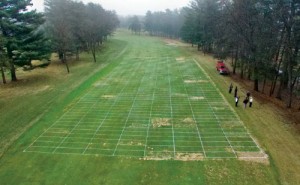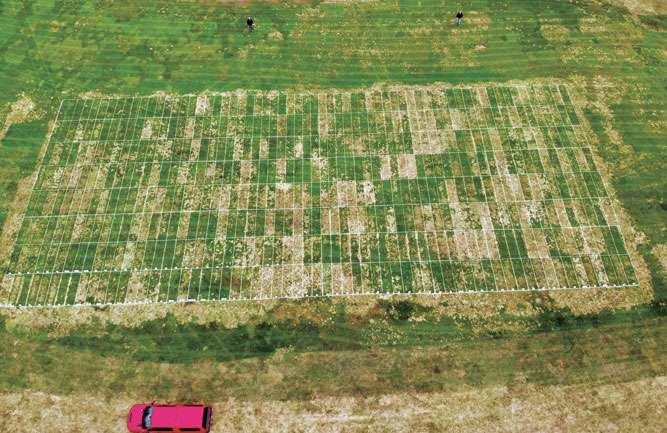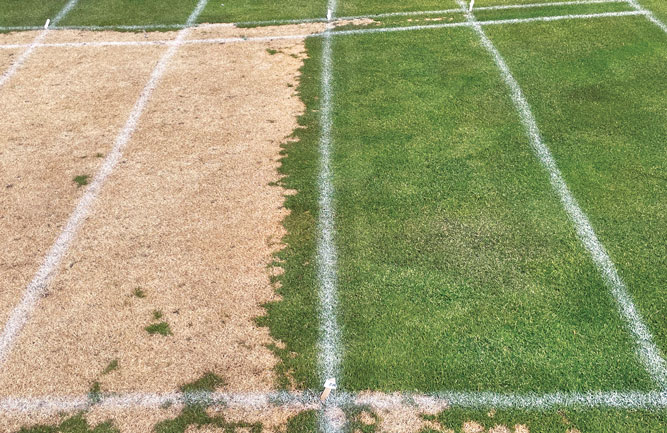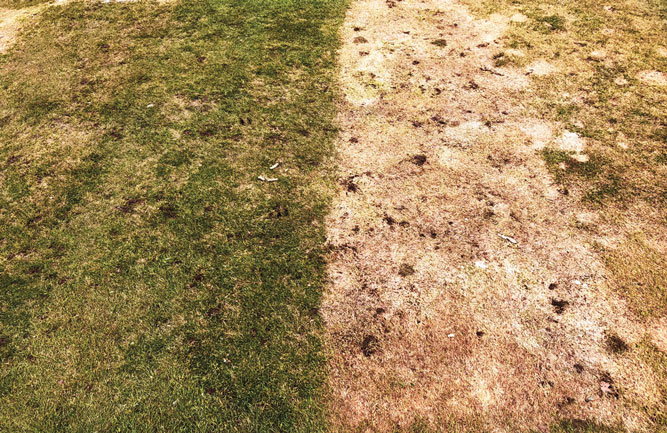One snow mold fungicide to rule them all?
Controlling multiple snow mold species with one application can be done, but not every product mixture provides the same results.
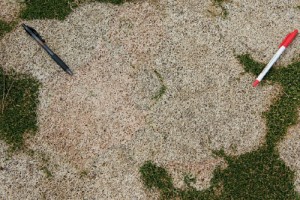
FIGURE 1: Speckled snow mold (red pen) and pink snow mold (black pen) growing in close proximity to each other on a golf course putting green in the spring of 2014.
(Click on the image to enlarge it.)
People like certainty, and whether it’s the daily weather forecast or a 30-year mortgage interest rate, it helps us plan effectively for the future.
| TABLE 1: Fungicides providing greater than 80 percent control of three snow mold diseases over a 3-year period* | ||
|---|---|---|
| Snow mold | Products providing > 80 percent control | |
| Pink snow mold (Microdochium nivale) |
PCNB, Compass | |
| Gray snow mold (Typhula incarnata) |
Heritage, Daconil WeatherStik, Prostar, PCNB, Banner MAXX, Insignia, Bayleton | |
| Speckled snow mold,(Typhula ishikariensis) | Banner MAXX | |
| *At Land O’Lakes GC in Land O’Lakes, Wis. Table reproduced from Jung et al. (2007) | ||
For many superintendents in temperate climates this is especially true about snow mold. Being certain that a fungicide applied in the fall will provide snow mold protection through snowmelt in the spring, no matter how nasty the winter, provides peace of mind and the ability to use the crucial spring period for improving the golf course, not repairing areas damaged by snow mold.
So why isn’t snow mold control more certain, at least relative to summer diseases like dollar spot and brown patch?
To start, we expect more from snow mold fungicides. Whereas summer fungicides are expected to provide 14 to 28 days of control, snow mold fungicides are expected to provide control for upward of 150 days in some locations. Second, a lot can happen to those fungicides over 150 days. Research recently completed at the University of Wisconsin showed that winter rainfall and snowmelt events quickly can deplete snow mold fungicides. If that depletion occurs early in the winter the turf will be susceptible to disease development for several months. Third, it’s important to remember when talking about snow mold that we’re talking primarily about three distinct diseases: pink snow mold (Microdochium nivale), gray snow mold (Typhula incarnata) and speckled snow mold (Typhula ishikariensis). While it’s not uncommon to see multiple snow mold diseases within close proximity of each other (Figure 1), each disease also has distinct environments where it causes the most damage. In addition, previous research has demonstrated that fungicides don’t equally control each snow mold effectively (Table 1). Choosing the wrong fungicide for the type of snow mold typically observed can lead to significant disease breakthrough come snowmelt in the spring.
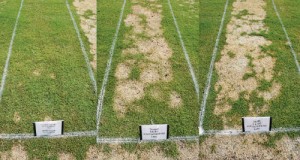
FIGURE 2: Combining Torque with 26/36 provided nearly complete snow mold protection, while removing either one of the two products leads to a near complete loss of protection. Photo originally published in August 2014 issue of Golfdom. (Click on the image to enlarge it.)
Why don’t we just control snow molds?
Fungicide manufacturers in recent years have released mixtures of multiple active ingredients from various chemical classes to improve the chances of controlling multiple snow mold diseases.
In addition, research at Wisconsin and elsewhere has demonstrated that single active ingredients do not provide effective snow mold control under heavy pressures, even when a single snow mold species predominates (Figure 2).
Multiple active ingredient products are presumably more effective because they control a broad range of snow mold pathogens and/or provide increased control of individual pathogens relative to a single active ingredient. While it’s clear that multiple active ingredients are required for effective snow mold suppression in northern climates, the exact impact that multiple active ingredients have on the fungus itself remains poorly understood.
Wisconsin conducts one of the largest snow mold research programs in the country, and in the winter of 2014–15 research was conducted on more than 100 treatments at six sites across Wisconsin, Minnesota and Michigan. The full research report for each site can be accessed at the University of Wisconsin’s Fungicide Research Results page (tdl.wisc.edu/results). In particular, the sites at Wausau CC in Schofield, Wis., (Figure 3) and Marquette (Mich.) CC (Figure 4) provided an excellent test of the treatments.
Though both sites experienced heavy disease pressure (Table 2), it was clear from looking at the results and the surface temperature that the disease pressure at Marquette CC was considerably higher than Wausau CC (Figure 5). In addition, the primary snow mold at Wausau was pink snow mold, while at Marquette it was speckled snow mold. Because many of the same products were tested at each site we can observe how the treatments performed against pink snow mold versus speckled snow mold and under high pressure (Wausau) versus extreme pressure (Marquette.)
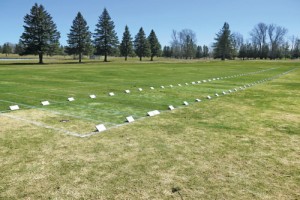
FIGURE 4: Snow mold research at Marquette Country Club in Marquette, Mich. in the spring of 2015.
(Click on the image to enlarge it.)
The results of both trials once again reveal the sheer number of fungicide combinations that provide effective snow mold suppression. At Wausau, 77 of 119 treatments provided greater than 98 percent control, while at Marquette, 62 of 101 treatments provided greater than 90 percent control. Table 2 provides a list of treatments that performed exceptionally well at both courses against both pink and speckled snow mold that followed disease pressure that was both high and extremely high. Most of the treatments on this list have been around and tested in our research and used by superintendents around the world for a number of years. These include Instrata, QP Enclave, Torque + 26/36, Turfcide and Concert + Turfcide. However, a few newer products and product combinations that previously had not been tested in our snow mold research program also performed exceptionally well at both sites, most notably Disarm T, Tourney + 26/36 and Interface + Mirage.
| TABLE 2: Select treatments that performed exceptionally well at both Wausau Country Club and Marquette Country Club during the winter of 2014–15* | ||||
|---|---|---|---|---|
| Disease severity (% disease) | ||||
| Treatment | Wausau | Marquette | Average | |
| Non-treated Control | 90.0 | 94.0 | 92.0 | |
| Instrata | 0.5 | 1.3 | 0.9 | |
| Turfcide | 0.0 | 5.0 | 2.5 | |
| Concert + Turfcide | 0.0 | 0.0 | 0.0 | |
| Torque + 26/36 | 0.5 | 2.5 | 1.5 | |
| Disarm T | 0.0 | 0.0 | 0.0 | |
| Tourney + 26/36 | 0.5 | 3.0 | 1.75 | |
| QP Enclave | 0.0 | 0.0 | 0.0 | |
| Interface + Mirage | 1.8 | 2.5 | 2.15 | |
| *The full report can be accessed at tdl.wisc.edu/results. | ||||
While many treatments performed exceptionally well, two treatments performed surprisingly poorly given a past history of success. Interface + Triton Flo performed exceptionally well in our trials dating back years and has become one of the standard treatments used in locations that experience heavy snow mold pressure. Lexicon + Trinity + Daconil Ultrex has also been successful in past trials under heavy disease pressure. Yet both performed poorly at our Marquette site this past year. This is not to demean these products, but rather to illustrate that even when an excellent product is applied at the proper time using the proper rate, you sometimes still get snow mold and you can’t really explain why. This same thing occurred in the winter of 2013–14 when Instrata inexplicably performed poorly under the heavy disease pressure observed at Marquette.
I have been involved in testing snow mold products at Wisconsin in some form since 2005, and unfortunately, inconsistent results from year to year is the most certain thing about snow mold control. If you typically experience heavy disease pressure, you can improve your odds of excellent suppression by using one of the mixtures listed in Table 2.
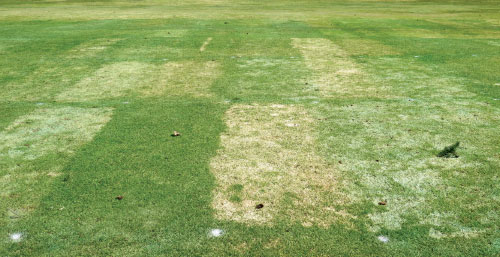
FIGURE 5: The most effective treatments provided excellent snow mold control under intense pressure at Marquette CC in 2014–15. However, less effective treatments had significant disease breakthrough.
(Click on the image to enlarge it.)
Acknowledgments
Special thanks to the six superintendents who hosted snow mold research sites this year: Mike Lemke at Nakoma CC, Randy Slavik at Wausau CC, Craig Moore at Marquette CC, Norma O’Leary at Silver Bay CC, Matt McKinnon at Cragun’s Resort and Tim Johnson at Spring Hill GC.
Author’s note
Listing of specific products in this article is based on research conducted at the University of Wisconsin and is not intended to be an endorsement of the product or of the manufacturer.
References
Jung, G., Chang, S. W., Jo, Y. K. 2007. A fresh look at fungicides for snow mold control. Golf Course Management 75(7): 91 – 94.
Koch, P. L., Stier, J. C., Kerns, J. P. 2015. Snow cover has variable effects on persistence of fungicides and their suppression of microdochium patch on amenity turfgrass. Plant Pathology. Doi: 10.1111/ppa.12379
Photos courtesy of: Paul Koch






